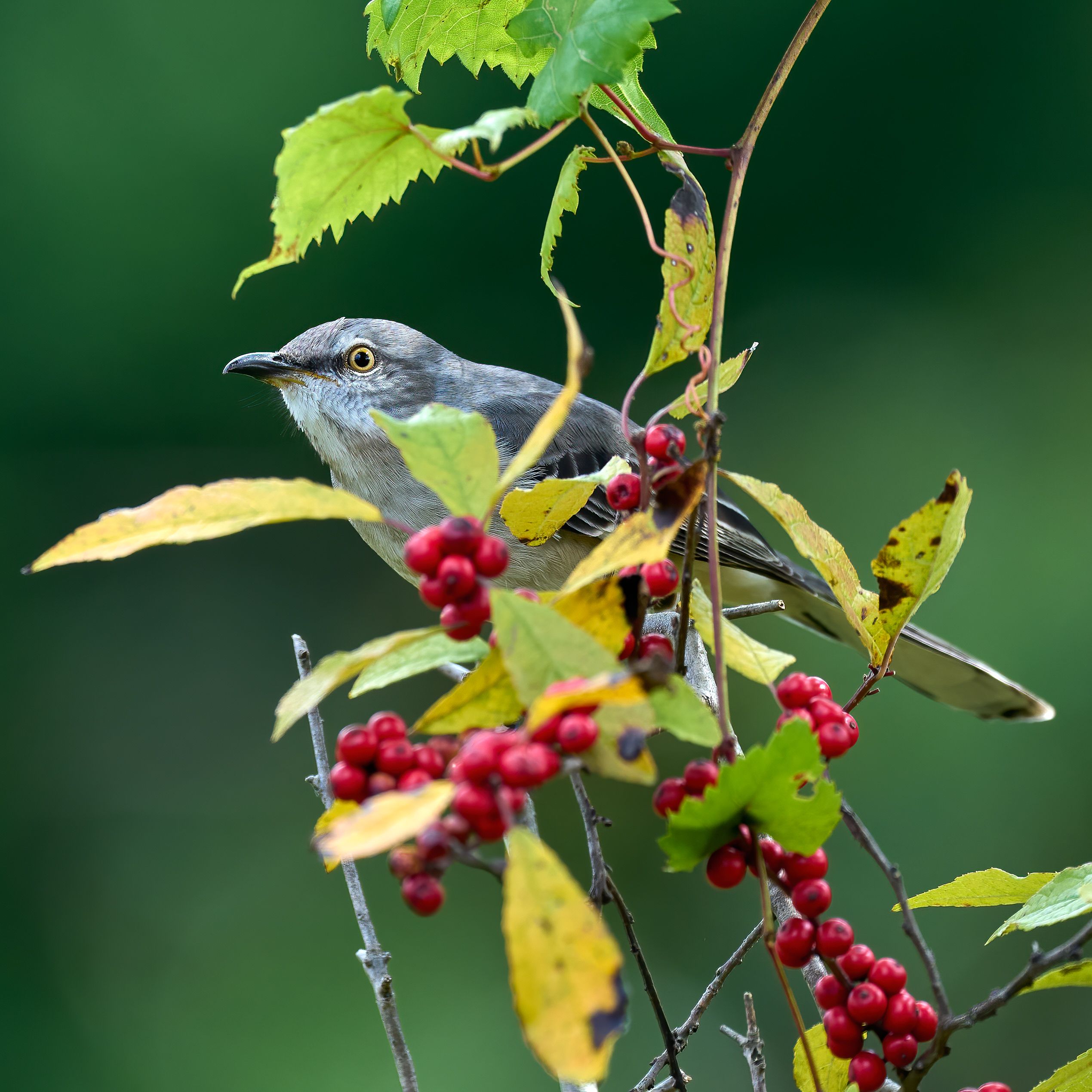The Master Mimic of the Bird World
The Northern Mockingbird is a bird that stands out not just for its appearance but for its incredible vocal range and ability to mimic other birds and sounds in its environment. Known for its adaptability, intelligence, and melodic repertoire, the Northern Mockingbird is a common yet captivating sight across North America. In this cornerstone post, we’ll explore the behavior, habitat, and fascinating vocal skills of this bird, along with tips for attracting and photographing these talented creatures.

Physical Characteristics
The Northern Mockingbird is a medium-sized songbird with a slender body and long tail. Its overall gray coloring and white underparts may seem modest compared to flashier species, but the white patches on its wings and tail are easily noticeable in flight.
- Size: 22–27 cm (8.7–10.6 in) in length
- Wingspan: 31–38 cm (12.2–15.0 in)
- Plumage: Primarily gray with white underparts and striking white wing patches.
- Beak: Thin, slightly curved, and black, perfect for catching insects.
While their appearance may seem understated, the real marvel of the Northern Mockingbird lies in its extraordinary voice.
Vocal Abilities and Mimicry
The Northern Mockingbird is famous for its ability to mimic a wide range of sounds, including the songs of other bird species, car alarms, and even the barking of dogs. Both males and females sing, though males are more vocal during breeding season. What makes them truly remarkable is their ability to cycle through a variety of tunes, sometimes mimicking up to 200 different sounds throughout their life.
- Mimicry: Mockingbirds are capable of imitating the calls of other birds, as well as man-made sounds. They often repeat a sound several times before moving on to the next.
- Song: Their song is loud, varied, and often continues well into the night during mating season. Male mockingbirds use their song to attract mates and defend their territory.
Mockingbirds are territorial year-round, and their songs play a crucial role in warding off intruders. They are known to aggressively defend their nests and feeding areas from larger birds and even humans.
Behavior and Diet
Northern Mockingbirds are highly active birds, often seen flitting between perches or running along the ground in search of food. They are also known for their characteristic wing-flashing behavior, where they quickly open and close their wings, exposing the white patches to startle insects into motion for easier capture.
- Diet: They are omnivores, feeding on a mix of insects and fruit. During the spring and summer, insects such as beetles, grasshoppers, and ants form the majority of their diet, while in the fall and winter, they switch to berries and other fruits.
- Behavior: Aside from their vocalizations, their bold and sometimes aggressive behavior sets them apart. They have been known to dive-bomb potential threats and vigorously defend their nests from predators or perceived intruders.
Habitat and Range
Northern Mockingbirds are highly adaptable and can thrive in a variety of environments. They prefer open areas with nearby shrubbery, such as gardens, parks, and forest edges.
- Range: The Northern Mockingbird is a year-round resident across much of the southern United States, extending into Mexico and the Caribbean. They are also found as far north as southern Canada during the warmer months.
- Habitat: These birds are commonly found in urban, suburban, and rural areas, often near people. They thrive in habitats with dense shrubs for nesting and open spaces for foraging.
Attracting Mockingbirds to Your Yard
To attract Northern Mockingbirds to your yard, consider offering a combination of food, water, and shelter:
- Food: Mockingbirds are particularly fond of fruits such as berries, so planting berry-producing shrubs like holly, mulberry, or elderberry can encourage them to visit. While they don’t typically visit feeders for seeds, suet or fruit feeders can attract them.
- Water: A birdbath or fountain is a great way to attract mockingbirds, as they enjoy drinking and bathing in fresh water.
- Shelter: Dense shrubs and trees offer the perfect environment for nesting. Mockingbirds prefer areas where they can easily spot predators or rivals.
Photographing the Northern Mockingbird
The Northern Mockingbird is a highly photogenic bird, with its smooth gray feathers and contrasting white patches. However, its fast, agile movements can make photographing it a bit of a challenge. Here are a few tips to help capture great shots:
- Be Patient: Mockingbirds are highly active, so patience is key. Observing their behavior and anticipating their next movement can help you capture action shots.
- Use a Telephoto Lens: A telephoto lens (such as the Sony FE 600mm F4 GM OSS) allows you to capture detailed shots from a distance without disturbing the bird.
- Light and Composition: Early morning or late afternoon provides the best natural light for photographing birds, reducing harsh shadows and highlighting their features.
Conservation Status
The Northern Mockingbird is not currently at risk, classified as a species of Least Concern by the IUCN Red List. However, like many bird species, they benefit from habitat preservation and thoughtful landscaping practices. Planting native shrubs and providing water sources can help ensure that mockingbirds and other backyard birds continue to thrive.
Species ID and External Resources
- Scientific Name: Mimus polyglottos
- Size: 22–27 cm (8.7–10.6 in) in length
- Wingspan: 31–38 cm (12.2–15.0 in)
For more detailed information on Northern Mockingbirds, check out the Cornell Lab of Ornithology’s Northern Mockingbird page.
Conclusion
The Northern Mockingbird is more than just a mimic—it’s a master of survival, a territorial guardian, and a captivating subject for birdwatchers and photographers alike. Whether you’re drawn to its varied song, its bold personality, or its striking wing patches, this bird never ceases to amaze. By attracting them to your yard, you can enjoy their company year-round, and with a little patience, you might just capture a perfect photograph of one in action.
